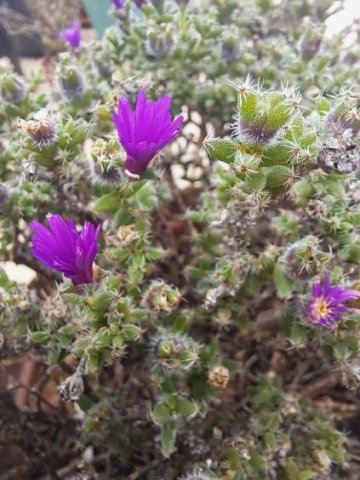Trichodiadema

Author: Ivan Lätti
Photographer: Francelle van Zyl
Trichodiadema is a genus of leaf succulent shrubs or shrublets in the Aizoaceae or mesemb family. Some plants bearing trailing, arched branches reach heights to about 60 cm, others with short branches only to about 3 cm. The roots are woody or tuberous, the tubers sometimes in clusters.
The opposite leaves are slightly connected or fused at the base and about cylindrical in shape. Several have star-shaped tufts of radiating, bristly hairs at their tips, likened to diadems. The generic name, Trichodiadema, is derived from the Greek words trix meaning hair and diadema meaning crown, referring to the hair tufts at the tips of leaves and the sepals of some. Those lacking the diadems are often mistaken for Drosanthemum. The leaf surfaces glisten from elevated bladder cells pointed at one or both ends, similar to Drosanthemum plants that usually lack the thick tuberous roots. In dry seasons the green leaves may turn red. Leaf length is up to 3 cm. The diadems may play a role in absorbing water into the leaves, particularly from dew.
The flowers grow solitary on short pedicels and without bracts. The flowers are up to 5 cm in diameter. There are five to eight sepals per flower with papillae on their surfaces, often with tufts off bristles at the tips like on the leaves. The linear to lance-shaped petals grow in one to several rings around the flower centres, coloured white, cream, yellow, orange and different shades of pink and purple. Trichodiadema plants mainly flower in winter to early summer.
The stamens as well as the filamentous staminodes that are also present are sometimes hairy at the base and cohering erectly in cones over the flower centres. The nectaries occur in the flower base, in the form of five to eight rounded glands around the stigmas. The ovaries are flat or convex, topped by five to eight lance-shaped stigmas, much shorter than the stamens.
The fruits resembling those of Drosanthemum have four to eight locules. The expanding keels are winged, close together but diverging towards their tips. The valve wings are broad and round. Covering membranes are present or reduced to limbs. There are no closing bodies. The yellow or brown seeds are pear-shaped, minutely warty and grooved.
There are about 34 species of Trichodiadema, all in more or less arid parts of southern Africa. The tuberous roots of some species have been used as a source of yeast in the past, sometimes called moervygie (yeast mesemb). Some species are used in horticulture. Several species are readily browsed by game and stock.
The plant in picture is Trichodiadema barbatum (Leistner, (Ed.), 2000; Smith, et al, 1998; Smith, et al, 2017; Vlok and Schutte-Vlok, 2015).

